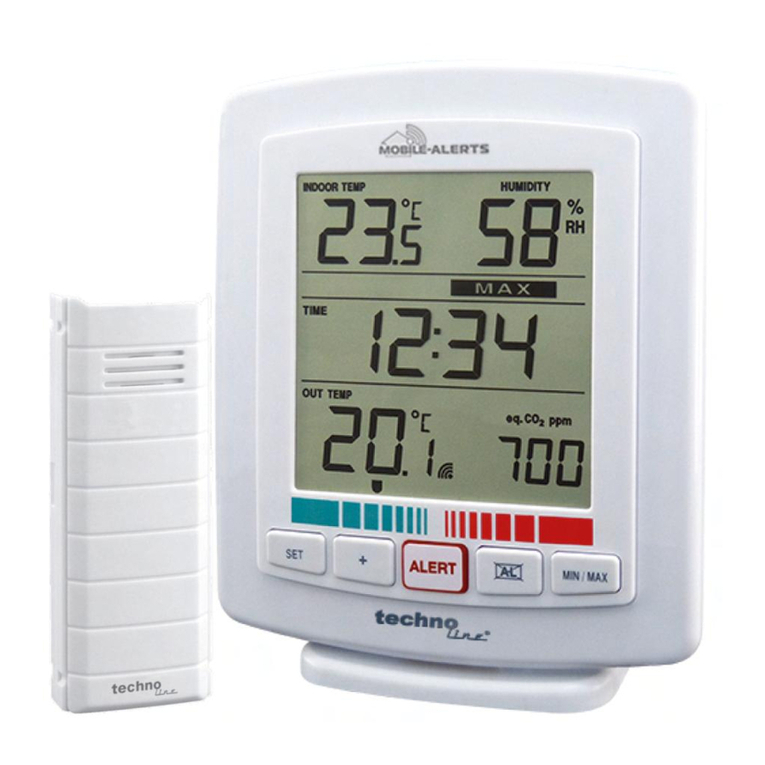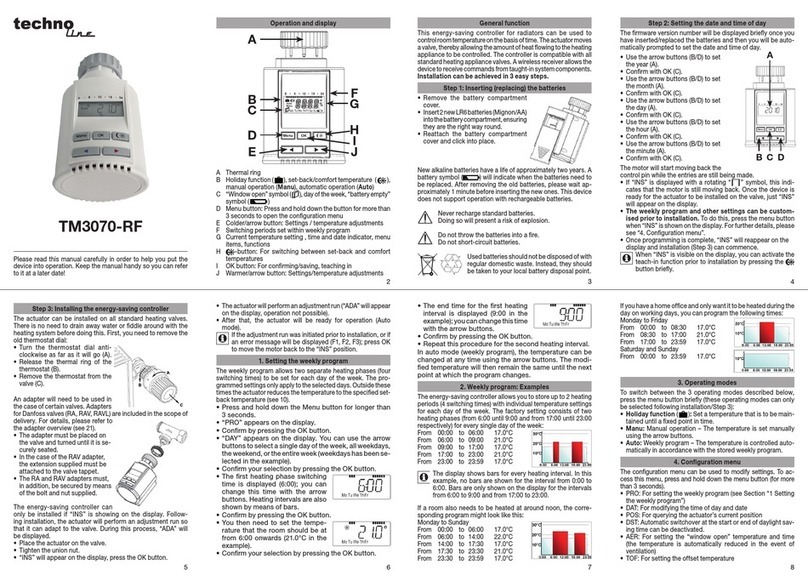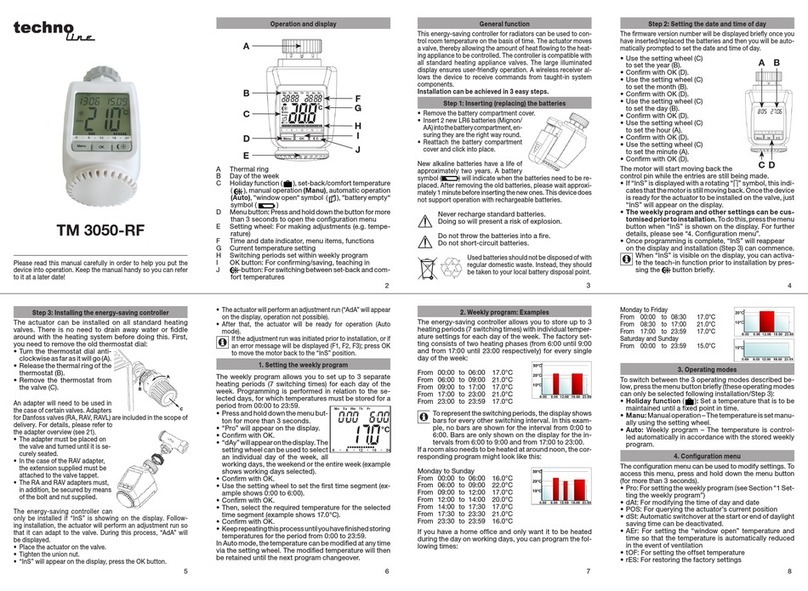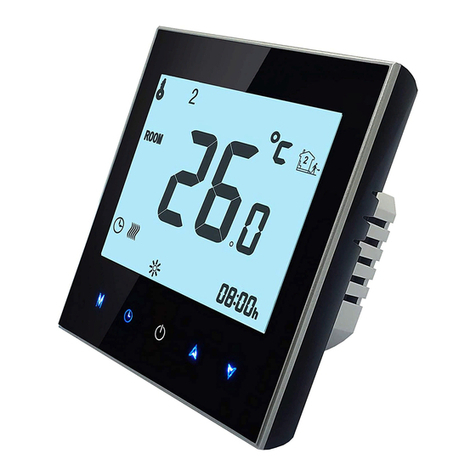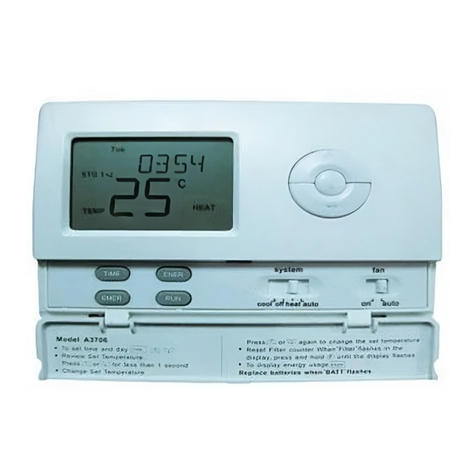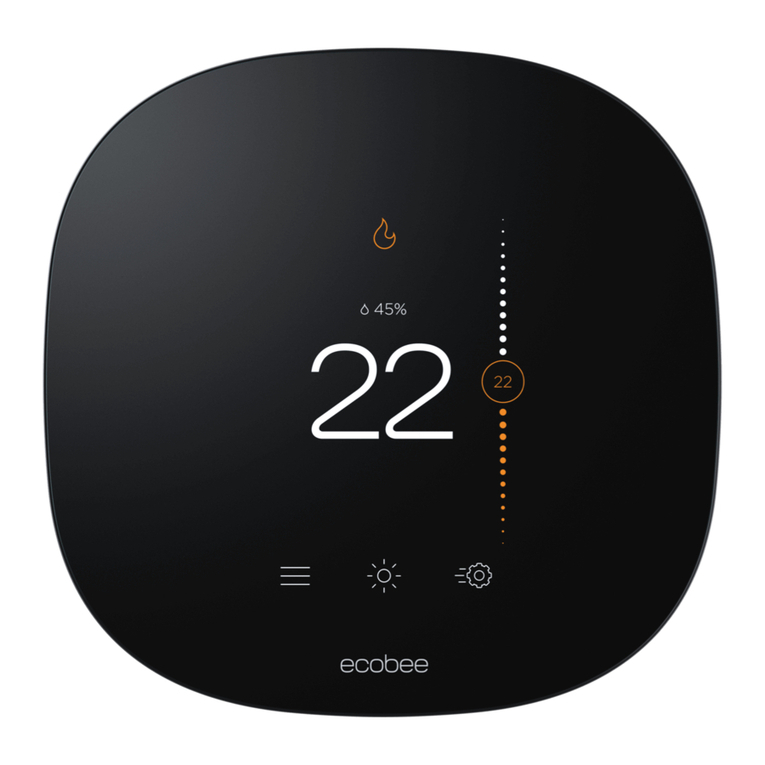Technoline TM 3080-RF User manual

TM 3080-RF
1. Operation and Display I Mode button: Press and hold down the button for more
than 3 seconds to open the configuration menu
J Settting wheel: for making adjustments (e.g. tempe-
rature)
2. Intended use
The wall thermostat is a user-friendly device for pro-
gramming and remotely controlling radio energy-saving
controllers for radiators.
The weekly program (see 8) set at the wall thermo-
stat is adopted by the taught-in radio energy-saving
controllers.
The wall thermostat features an internal sensor for
measuring a room’s temperature and humidity, with the
detected temperature then being transferred to the radio
energy-saving controllers.
System components such as outdoor temperature
sensors, remote controls and window contacts can also
be taught-in to the wall thermostat.
The device may only be operated indoors and must be
protected from the effects of damp and dust, as well as
solar or other methods of heat radiation.
Using the device for any purpose other than what is de-
scribed in this operating manual does not fall within the
scope of intended use and shall invalidate any warranty
or liability. This also applies to any conversion or modi-
fication work.
This device is intended for domestic use only.
3. Inserting (replacing) the batteries
Remove the battery compart-•
ment cover.
Insert 2 new LR06 (Mignon/AA)•
batteries into the battery com-
partment.
Reattach the battery compart-•
ment cover and click into place.
New alkaline batteries have a life of
approximately two years. A battery
symbol ( ) will indicate when
the batteries need to be replaced.
Never recharge standard batteries.
Doing so will present a risk of explosion.
Do not throw the batteries into a fire.
Do not short-circuit batteries.
Used batteries should not be disposed
of with regular domestic waste. Instead,
take them to your local battery dispos-
al point.
4. Setting the date and time of day
The firmware version number will be displayed briefly
once you have inserted/replaced the batteries and then
you will be automatically prompted to set the date and
time of day.
Use the setting wheel (D) to set the year (B).•
Confirm with OK (C).•
Use the setting wheel (D)•
to set the month (B).
Confirm with OK (C).•
Use the setting wheel (D)•
to set the day (B).
Confirm with OK (C).•
Use the setting wheel (D)•
to set the hour (A).
Confirm with OK (C).•
Use the setting wheel (D)•
to set the minute (A).
Confirm with OK (C).•
After setting time and date
the display will then switch
to normal view.
5. Mounting of wall thermostat
The wall thermostat must be mounted in the same room
as the devices, such as radio energy-saving controllers,
window contacts or remote controls, that have been
taught-in to it.
First of all, find an appropriate moun-•
ting location, making sure that no
electricity or similar lines run there.
Use a pen to mark the bore hole posi-•
tions (a) of the wall mount on the wall.
If you are working with a stone wall,•
you should drill the holes using a
5 mm drill. Then insert
a plug into each of the
drilled holes.
If you are working with a•
wooden wall, you should
drill the marked holes (a) using a 1.5 mm drill.
Now use screws to fix the wall mount to the wall.•
Slide the wall thermostat down from above onto the•
wall mount.
6. Operating modes
To switch between the 3 operating modes described
below, press the mode button briefly:
Holiday function• ( ): Set a temperature that is to be
maintained until a fixed point in time.
Manu:• Manual operation – The temperature is set ma-
nually using the setting wheel.
Auto:• Weekly program – The temperature is controlled
automatically in accordance with the stored weekly
program.
7. Configuration menu
The configuration menu can be used to modify settings.
To access this menu, press and hold down the mode but-
ton (for more than 3 seconds).
Pro• : For setting the weekly program (see Section “8 Set-
ting the weekly program”)
dAt• : For modifying the time of day and date
CAL• : Time setting for descaling function
dSt• : Automatic switchover at the start or end of daylight
saving time can be deactivated.
AEr• : For setting the “window open” temperature so that
the temperature is automatically reduced in the event
of ventilation
rES• : For restoring the factory settings
UnL• : For teaching out all taught-in wireless compo-
nents
Use the setting wheel to select menu items and the OK but-
ton to confirm your choice. Press the mode button again
to return to the previous level. After 60 seconds without
anything happening, the menu will close automatically.
8. Setting the weekly program
The weekly program allows you to set up to 3 separate
heating periods (7 switching times) for each day of the
week. Programming is performed in relation to the se-
lected days, for which temperatures must be stored for a
period from 00:00 to 23:59.
Press and hold down the mode•
button for more than 3 se-
conds.
“Pro” will appear on the display.•
Confirm with OK.•
“dAy” will appear on the dis-•
play.
The setting wheel can be used to select an individual day•
of the week, all working days, the weekend or the entire
week (example shows working days selected).
Confirm with OK.•
Use the setting wheel to set the first time segment•
(example shows 0:00 to 6:00).
Confirm with OK.•
Then, select the required temperature for the selected•
time segment (example shows 17.0°C).
Confirm with OK.•
Keep repeatingthis process until you havefinished storing•
temperatures for the period from 0:00 to 23:59.
In Auto mode, the set weekly program is adopted by the
taught-in radio energy-saving controllers automatically
and the temperature can be modified at any time via the
setting wheel. The modified temperature will then be re-
tained until the next program changeover.
9. Weekly program: Examples
The wall thermostat allows you to store up to 3 heating
periods (7 switching times) with individual temperature
settings for each day of the week. The factory setting
consists of two heating phases (from 6:00 until 9:00 and
from 17:00 until 23:00 respectively) for every single day
of the week:
From 00:00 to 06:00 17.0°C
From 06:00 to 09:00 21.0°C
From 09:00 to 17:00 17.0°C
From 17:00 to 23:00 21.0°C
From 23:00 to 23:59 17.0°C
To represent the switching periods, the display shows
bars for every other switching interval. In this examp-
le, no bars are shown for the interval.
If a room also needs to be heated at around noon, the cor-
responding program might look like this:
Monday to Sunday
From 00:00 to 06:00 16.0°C
From 06:00 to 09:00 22.0°C
From 09:00 to 12:00 17.0°C
From 12:00 to 14:00 20.0°C
From 14:00 to 17:30 17.0°C
From 17:30 to 23:30 21.0°C
From 23:30 to 23:59 16.0°C
If you have a home office and only want it to be heated
during the day on working days, you can program the fol-
lowing times:
Please read this manual carefully in order to help you put
the device into operation. Keep the manual handy so you
can refer to it at a later date!
A Switching periods set within weekly program
B Time & date indicator, indoor-humidity (% RH) & tem-
perature, indoor- and outdoor-temperature, outdoor-
min- & max-temperature; functions
C Holiday function ( ), manual operation (Manu), au-
tomatic operation (Auto), “battery empty“ symbol
( ), set-back/comfort temperature ( ), “window
open” symbol ( )
D Display button: Switch between display modes (e.g.
time & date or indoor-humidity & -temperature)
E OK button: For confirming/saving, teaching in
F Current temperature setting, functions
G Day of the week
H -bu tton: Fo r switc hing b etwe en se t-bac k and c o m-
fort temperatures
5
2
6
3
7
4
8
A
B
C
D
EI
F
G
J
H
a a
A
C
B
D

Monday to Sunday
From 00:00 to 08:30 17.0°C
From 08:30 to 17:00 21.0°C
From 17:00 to 23:59 17.0°C
Saturday and Sunday
From 00:00 to 23:59 15.0°C
10. Display content during normal operation
During normal operation, the display
shows: switching periods, indoor hu-
midity, indoor temperature, operating
mode, temperature setting and day
of the week. The bars indicating the
weekly program’s switching periods
are shown for every other time interval. For an example,
please refer to “9. Weekly program: Examples”.
11. Changing the display view
The upper part of the display can be used to show oth-
er values instead of the indoor humidity and the indoor
temperature. The Display button is used to change the
view. The following alternatives are available, depending
on whether or not an outdoor temperature sensor has been
taught-in to the wall thermostat:
No outdoor sensor With outdoor sensor
Indoor humidity and
temperature
Indoor humidity and
temperature
Time and date Outdoor and indoor
temperature
Min. and max. outdoor
temperature
Time and date
You can delete the saved min./max. outdoor temperature
values by pressing and holding down the Display button
for longer than 3 seconds.
12. Teaching-in to radio energy-saving controllers
In order to enable communication between radio com-
ponents, the devices have to be taught-in to one another.
Proceed as follows to allow radio energy-saving control-
lers to be managed via a wall thermostat:
First of all, the radio energy-saving controller must be set•
to teach-in mode. For more information on this, refer to
the operating manual for the relevant device.
The wall thermostat then needs to transmit a radio signal for•
t e a c h i n g - i n p u r p o s e s . To d o t h i s , p r e s s a n d h o l d d o w n t h e O K
button on the wall thermostat for longer than 3 seconds.
“LEA” and the remaining teach-in time (starting at 30•
seconds) appear on the display and the wall thermostat
transmits a teach-in signal.
When the radio energy-saving controller receives the•
teach-in signal, “ECF” appears on its display.
The wall thermostat can be taught-in to as many radio
energy-saving controllers as you wish.
If there is interference in terms of radio communica-
tion, the radio energy-saving controller continues to
regulate the temperature autonomously, in accordance
with the most recent specifications made by the wall ther-
mostat.
Remote controls or win dow contacts that have previ-
ously been taught-in to the radio energy-saving con-
troller must be taught-in to the wall thermostat directly.
If the batteries in a radio energy-saving controller
have been replaced, it can take up to 1½ hours until
the actuator starts to receive data from the wall thermo-
stat again and switches to “ECF” mode.
13. Teaching-in to the wall thermostat
Up to 5 system components such as remote controls,
window contacts or additional outdoor temperature
sensors can be taught-in to the wall thermostat.
To do this, press and hold down the OK button for long-•
er than 3 seconds.
“LEA” and the remaining teach-in time (30 seconds)•
appear on the display.
The device to be taught-in now needs to transmit a ra-•
dio signal (by pressing a button on a remote control,
for example).
Once teaching-in has been completed successfully, a•
code for the taught-in device appears on the wall ther-
mostat’s display for 3 seconds: rC – remote control, SC
– window contact, Ot – outdoor temperature sensor.
The display then returns to the standard view.•
If 5 devices have already been taught-in to the wall
thermostat, “Err” appears on the display. In this case,
one of the taught-in devices needs to be taught-out before
a new device can be taught-in (see 14).
14. Teaching out wireless components
Components that have been taught in on the actuator
can be taught out again using the “UnL” (Unlearn) func-
tion. All wireless components are taught out at once with
this function.
Press and hold down the mode button for more than•
3 seconds.
Use the setting wheel to select the “UnL” menu item.•
Confirm with OK.•
”ACC” will appear on the display; press OK to confirm.•
15. Comfort and set-back temperatures
The comfort/set-back temperature button ( ) provides
an easy and convenient way of switching between these
two temperatures. The factory settings are 21.0°C and
17.0°C respectively. To adapt them, proceed as follows:
Press and hold down the comfort/set-back temperature•
button ( ) for more than 3 seconds.
The sun symbol (• ) will appear on the display along
with the current comfort temperature.
Use the setting wheel to modify the temperature; press•
OK to confirm.
The moon symbol (• ) will appear together with the set-
back temperature.
Use the setting wheel to modify the temperature; press•
OK to confirm.
The temperature can even be modified in Auto mode at any
time by using this button. The new setting will be retained
until the program’s next switching time.
16. Setting the holiday function
If you want a fixed temperature to be maintained for a set
period of time while you are on holiday or during a party,
you can make use of the Holiday function.
Press and release the mode button repeatedly until the•
suitcase symbol ( ) appears on the display.
Use the setting wheel to set the end of the time period•
during which the temperature is to be maintained.
Press the OK button to confirm.•
Then use the setting wheel to set the date.•
Press the OK button to confirm.•
Use the setting wheel to set the temperature; press OK to•
confirm. The display will flash to confirm your settings.
The set temperature will remain in force until the specified
time. After that, the wall thermostat will adopt Auto mode.
Wireless commands from the window contact and remote
control will continue to be executed.
17. Setting routine descaling
Routine descaling is carried out once a week to protect
against valve calcification. The user can change the time
at which this function is performed (factory set is 12:00
on Saturdays).
Press and hold down the Mode button for more than•
3 sec.
Use the handwheel to select the “CAL” menu item.•
Confirm your selection by pressing the OK button.•
Use the handwheel to select the day of the week.•
Confirm your selection by pressing the OK button.•
Use the handwheel to select the time.•
Confirm your selection by pressing the OK button.•
18. “Window open” function
If a window contact has been taught-in to the wall ther-
mostat, it will automatically lower the temperature when
windows are open. That allows to save on heating costs.
Whilst this function is active, the “window open” symbol
( ) appears on the display. The target temperature which
applies here is adjustable.
Hold down the mode button for more than 3 seconds.•
Use the setting wheel to select the “AEr” menu item.•
Confirm with OK.•
Use the setting wheel to set the temperature.•
press OK to confirm.•
19. Restoring the factory settings
You can reset the wall thermostat to its initial state. This will
clear all the settings that have been made manually.
Hold down the mode button for more than 3 seconds.•
Use the setting wheel to select the “rES” menu item.•
Confirm with OK.•
“ACC” will appear on the display; press OK to confirm.•
20. Child-proof lock/Operating inhibit
Operation can be inhibited.
To activate/deactivate the operating inhibit, briefly press•
the “Mode” and buttons at the same time.
After activation, “LOC” will appear on the display.•
To deactivate the function, press both buttons again.•
21. Setting the heating break
If the heating is turned off during summer, the batteries in
the radio energy-saving controllers can be saved. To achieve
this , the val ves ar e o pen ed fu lly an d the ca lci ficat ion pr otec -
tion function continues to run. Radio commands from win-
dow contacts or remote controls are no longer executed.
To activate the heating break, turn the setting wheel•
clockwise during manual operation (Manu) until “On”
appears on the display.
To terminate the heating break quit manual operation•
(Manu) or turn the setting wheel anticlockwise.
22. Setting frost protection mode
If you do not want the room to be heated, the valve can be
clo s ed. I t will on ly be o pen ed ag a in if t h ere i s a ris k of fre e-
zing due to frost. Limescale protection measures remain
in place. Wireless commands from the window contact or
remote control will no longer be executed.
and the reception characteristics of the receiver, envi-
ronmental factors such as humidity in the vicinity have
an important role to play, as do on-site structural/screen-
ing conditions.
Techno Trade Import-Export GmbH hereby declares that
this device complies with the essential requirements and
other relevant regulations of Directive 1999/5/EC. You can
find the full declaration of conformity at
www.technoline-berlin.de/Konformitaetserklaerung.
26. Technical specifications
Supply voltage: 3 V
Max. current consumption: 30 mA
Batteries: 2 x LR06 (Mignon/AA)
Batterie life: approx. 2 years
Display: LC-Display
Radio frequency: 868,3 MHz
Range of transmission
in open air: 20 m
Housing dimensions: 82 x 92 x 30 mm (W x H x D)
We reserve the right to make any technical changes
that constitute an improvement to the device.
Issue 1 English 02/2010
Documentation © 2009 TechnoTrade Import-Export GmbH, Wildau.
All rights reserved.
CC-TC-O-WM-W-R3, V1.2 907-40
9
13
10
14
11
15
12
16
To activate frost protection mode, turn the setting wheel•
anticlockwise during manual operation (Manu) until “OFF”
appears on the display.
To terminate frost protection mode, quit manual opera-•
tion (Manu) or turn the setting wheel clockwise.
23. Instructions for disposal
Do not dispose of the device with regular
domestic waste.
Electronic equipment must be disposed of at lo-
cal collection points for waste electronic equip-
ment in compliance with the Waste Electrical and
Electronic Equipment Directive.
The CE Marking is simply an official symbol relat-
ing to the free movement of a product; it does not
warrant a product’s characteristics.
24. Safety instructions
This device is not a toy; do not allow children to play with
it. Do not leave packaging material lying around, as it can
be dangerous in the hands of a child. Do not open the de-
vice: it does not contain any components that need to be
serviced by the user. In the event of an error, please return
the device to our service department.
25. General Information about radio operation
Radio transmission is performed on a non-exclusive trans-
mission path, which means that there is a possibility of
interference occurring.
Interference can also be caused by switching operations,
electrical motors or defective electrical devices. The range
of transmission within buildings can differ greatly from that
available in the open air. Besides the transmitting power
Other Technoline Thermostat manuals
Popular Thermostat manuals by other brands
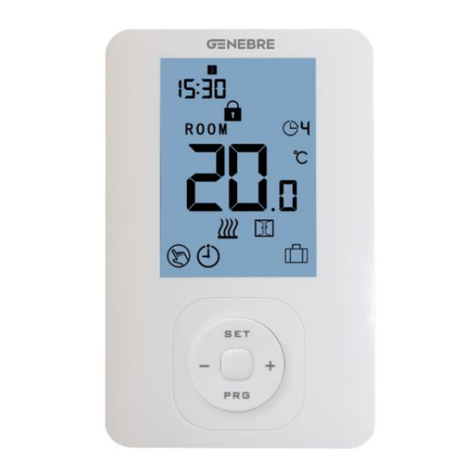
Genebre
Genebre 3917 quick start guide

Honeywell
Honeywell RTH2510 Series operating manual
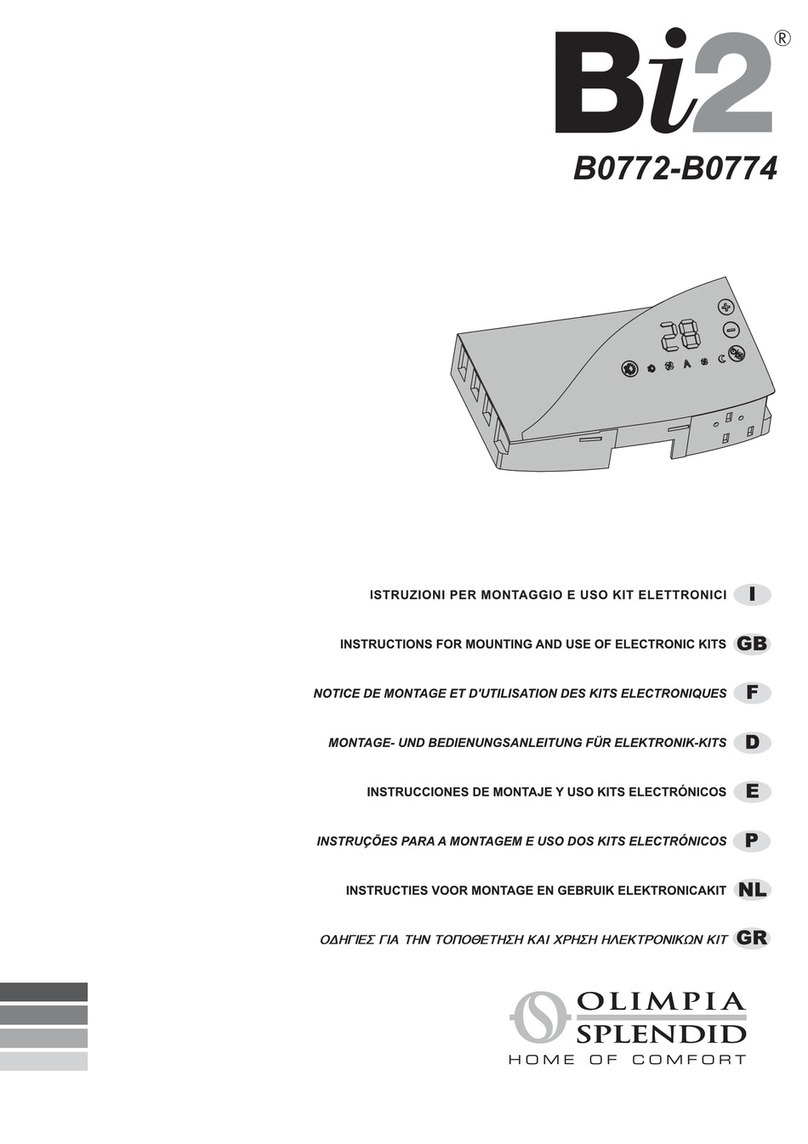
Olimpia splendid
Olimpia splendid Bi2 B0772 Instructions for mounting and use
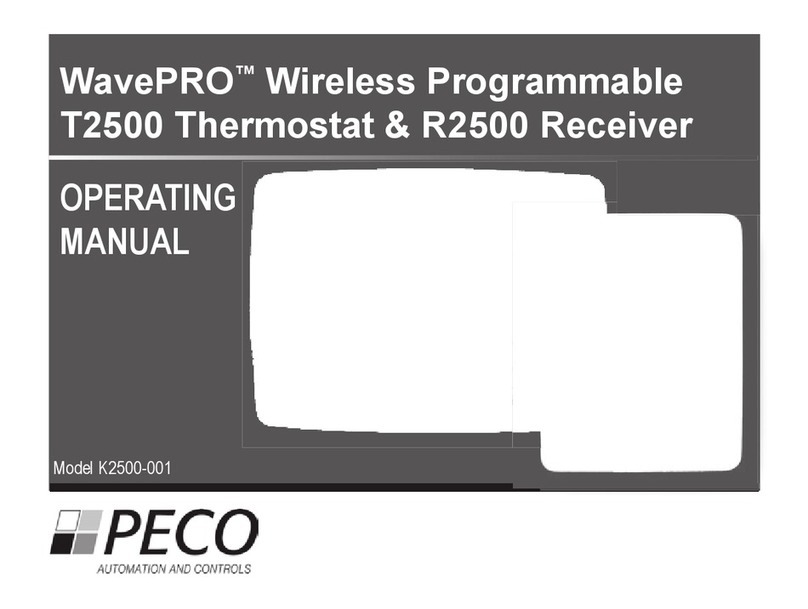
Peco
Peco WavePRO T2500 operating manual

SOMFY
SOMFY Soliris Smoove IB+ installation guide

White Rodgers
White Rodgers 1F97W-51 installation instructions
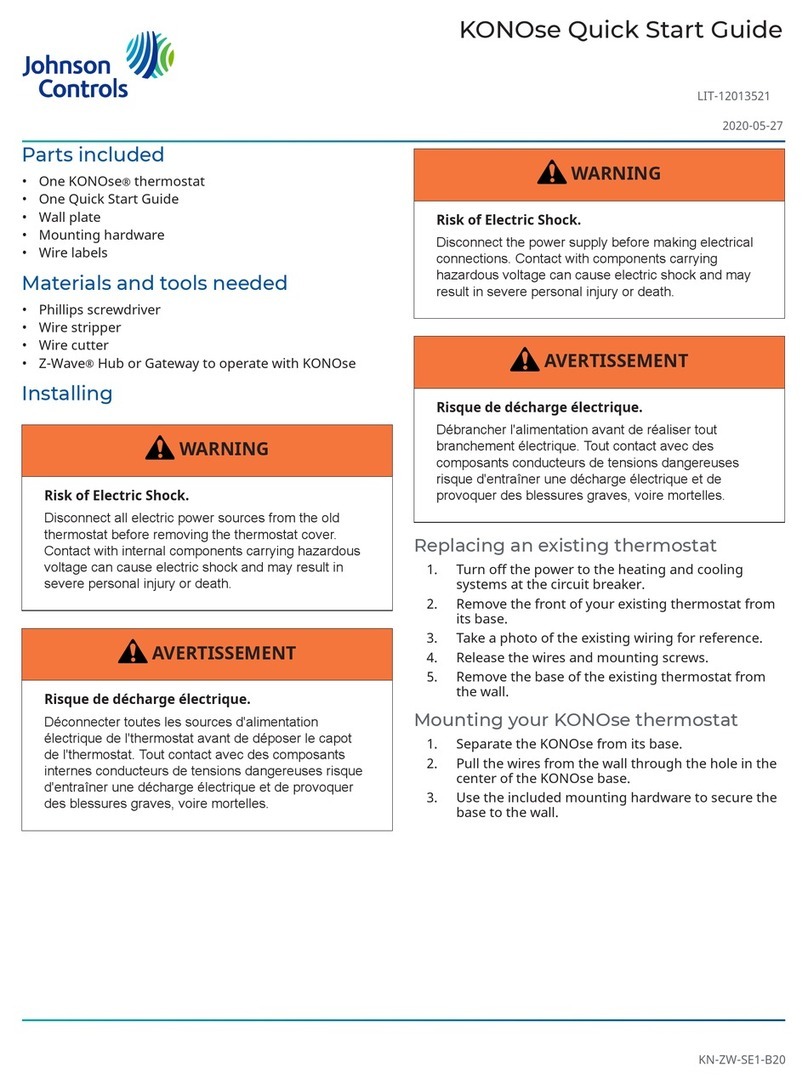
Johnson Controls
Johnson Controls KONOse quick start guide
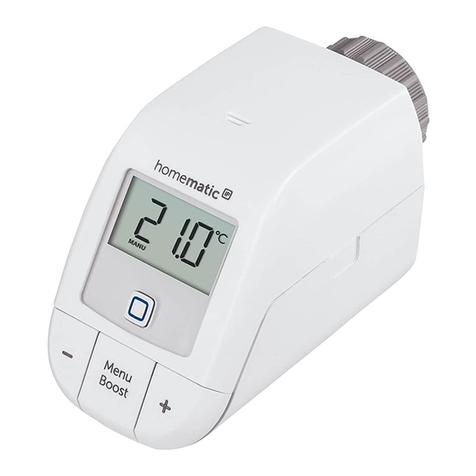
HomeMatic
HomeMatic HmIP-eTRV-B-2 Installation and operating manual
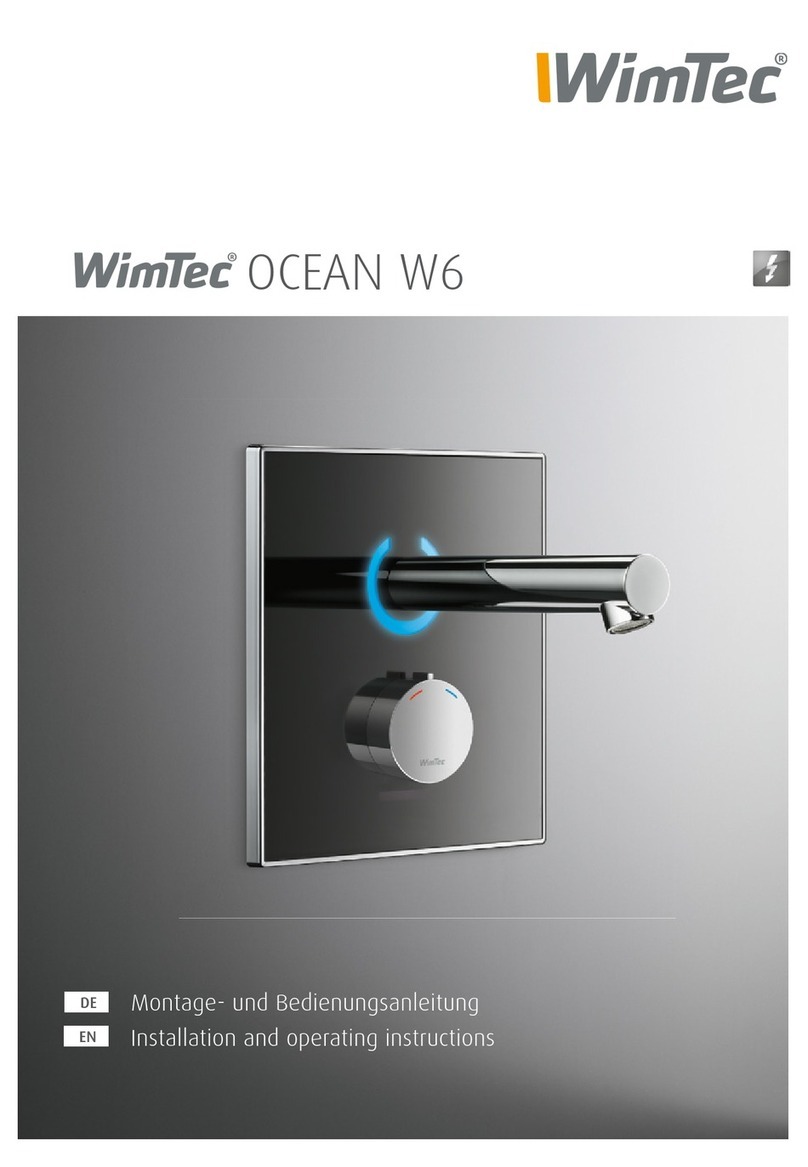
WimTec
WimTec OCEAN W6 Installation and operating instructions
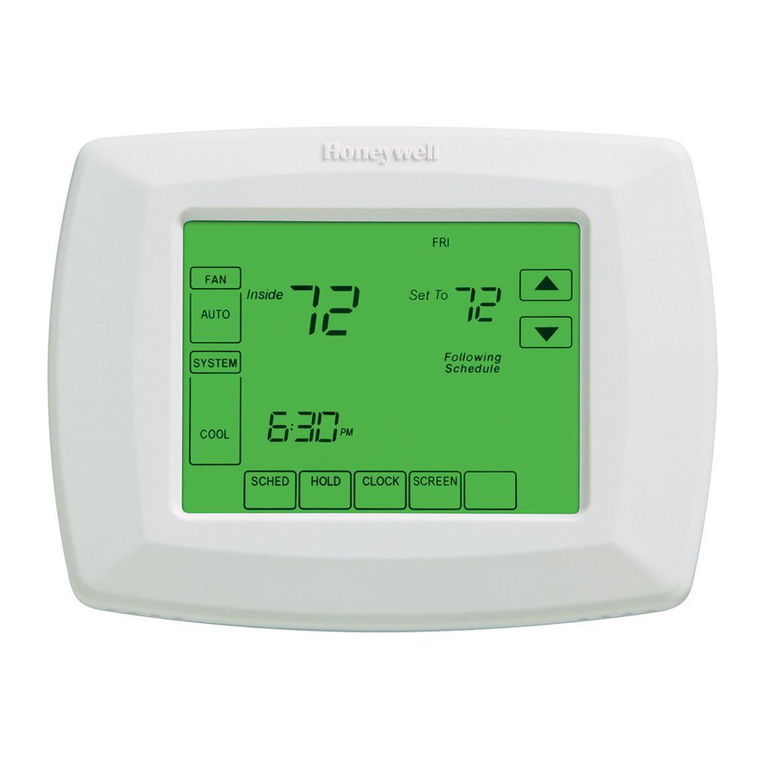
Honeywell
Honeywell RTH8500 Series owner's manual
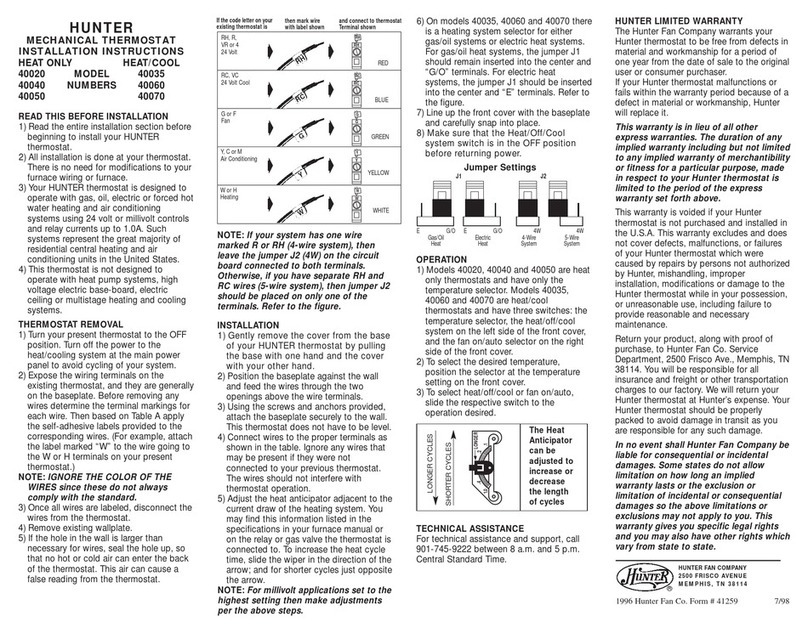
Hunter
Hunter 40020 installation instructions
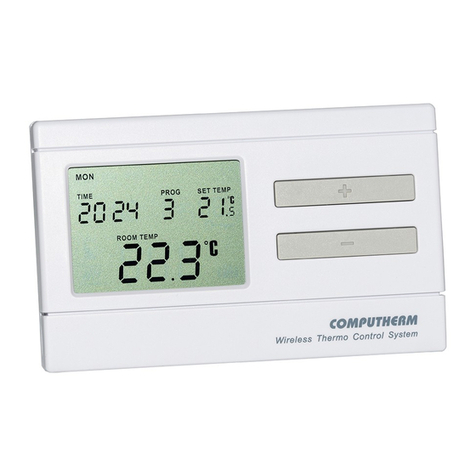
Computherm
Computherm Q7 operating instructions
